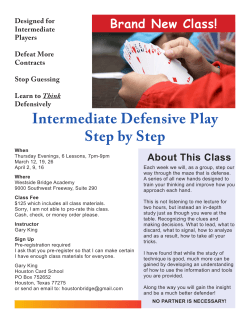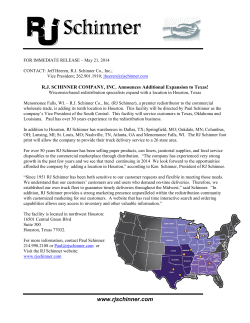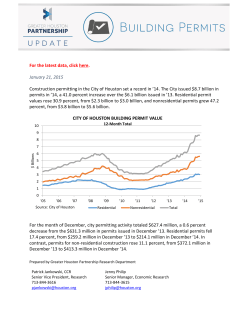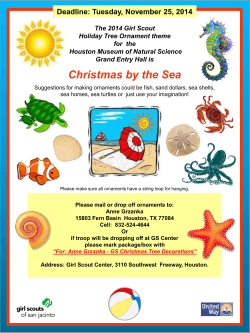
2015 COSET Research Day Program
2015 COSET Research Day Program Wednesday, April 1st, 2015 LOCATION: Science Building Room 303 H 8:45am – 8:55am WELCOME AND OPENING REMARKS Lei Yu, Dean, College of Science, Engineering and Technology Lila Ghemri, Chair, COSET Research Committee 9:00am-10:55am PRESENTATIONS 9:00 Estimate a Quick Table by Analyzing the Relationship between pH, Temperature, and BOD at Galveston bay Po-Hsien Kuo –Transportation Studies 9:20 Efficient Parallel Algorithms for K-D Tree Traversal Emma Hamilton- Computer Science 9:40 Developing a Framework to Test Driving Performance at LeftTurn Movement with Smartphone Based Warning Message Mahreen Nabi- Transportation Studies 10:00 Association Analysis of Travel Time to Work and Diagnosed Diabetes Incidence in Texas Bo Wei- Environmental and Interdisciplinary Sciences 10:20 Immune Modulation in Normal Human Lymphocytes on ISS Ivory Ellis- Biology 10:40 Instantaneous Prediction of GHG Emission Based on a Learning Model. Wu Ying-Transportation Studies 11:00am-12:00pm PANEL DISCUSSION: How to Negotiate Graduate School? LOCATION: Science Building Room 156 12:15pm- 1:15pm INVITED TALK James Briggs Interim Chair and Associate Professor, Department of Biology and Biochemistry, University of Houston Computational biophysics and drug discovery Computational methods can be used to predict the behavior of biomolecular systems. These include methods that can be used in computer-aided drug discovery and in computational biophysics. Methods that are in use in my research include molecular dynamics, docking, virtual screening, homology modeling, and more. Students who get trained in these areas are well-suited for careers in pharmaceutical and biotechnology companies. The vast majority of these companies use computational methods in the design phase of their work, largely to reduce the time and cost to product/service. Computational scientists are typically part of interdisciplinary teams with wet experimentalists. Therefore, it is crucial that the computational scientists know how to communicate effectively and broadly with other scientists. Two specific examples will be given of our computational work. One is focused on elucidation of the correlation between protein structure/dynamics of the wild-type and mutants and their resulting cancer phenotype. The other is a drug discovery target that helps to control addiction. Biography: Dr. James Briggs is Interim Chair and Associate Professor at the Department of Biology and Biochemistry at the University of Houston. He received a bachelor in Chemistry from the University of Texas at ElPaso and a PhD in Theoretical Organic Chemistry from Purdue University, in West Lafayette, Indiana. He then joined the University of Houston in 1990, first as a post doc, then as an Associate Researcher in Chemistry at the Department of Chemistry and Biochemistry and grew through the ranks until his current position. He and his collaborators hold a patent related to Enzymatic nucleic acid synthesis. He has been a NASA collaborating investigator for 11 years and has received numerous grants and awards to support his research and fund his students. To date, he has mentored 17 PhD students, 8 postdoctoral and several Masters and undergraduate students preparing their Honors theses. 1:15pm-1:45pm BREAK LOCATION: Science Building Room 303 H 1:50pm-2:45pm PRESENTATIONS 1:50 Develop an Android Remote Experiment App Based on Unified Remote Laboratory Framework Qianlong Lan, Computer Science 2:10 Evaluating the Impact of Smartphone Based Safe Worker App to Enhance Safety in Activity Area of Work Zone. Ruksana Rahman, Transportation Studies 2:30 pm-2:55 pm BREAK 3:00pm-4:40 pm PRESENTATIONS 3:00 Noise Reduction by Transparent Plastic Acoustic Barriers on I-30, Dallas, Texas Boya You- Transportation Studies 3:20 K-D Tree Construction for Solving N-Body Problem Sabrina Shahnaj- Computer Science 3:40 Effects of Different Pavements on In-vehicle Noises along Houston Highways Qing Li- Environmental and Interdisciplinary Sciences 4:00 4:20 Driving Behavior and Dilemma Zone Analysis at Yellow Interval with Advanced Warning Message under Foggy Weather Condition: A Simulator Test Johara Munni-Transportation Studies PROGRAM CLOSES
© Copyright 2025





















